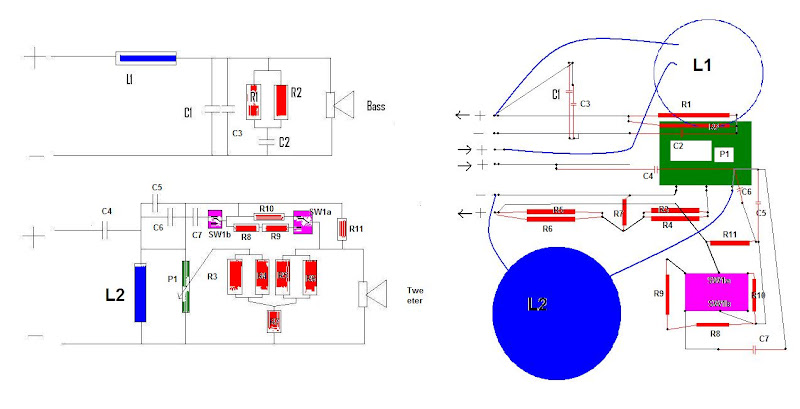Pucho,
I'm not really good in drawing and I don't have a dedicated program therefor.
The naming on the left side (schematic) is the same than on the right side of the picture (this is graphically, what I've seen on the photos).
The blue ones are the inductors
L1 for the bass
L2 for the tweeter
The red ones are the resistors
the green P1 is the pot
the pink is the switch with 2 separated layers.
The traces, that I am sure about are black. Two traces, I am not sure about, are grey (just in the right picture).
*So, a very important point is to clarify, if the scematic is right or not right.
*For the values, resistors could be identified via color codes. On the pics the are not really good to identify for me, since colors on photos always differ. To be honest, for some resistors this might be the only way to figure out the values, since one might not be able to measure the resistor only. So it would be great after clarifying the schematic to determine the resistors color code.
*If you cant figure out the inductors, it would help to know the outer and inner diameter, teh thickness of the wire and the thickness of the coil.
* the capacitors should have their values written on themselfes. The values of the small might not be so important if there is no value on.
* the value of the pot would be an important one, but probably difficult to get in case of there is no bagde on it.
Of course, the more info you can get from Manley the better it is. But if we can figure out all of them without further info, why not do it without them. It depends, how far you want to go. It might be necessary to take a soldering iron to get everything we need, or ask again Manley. So we absolutely depend on your kindness!
Which mighty peace of information is in the documentation you got from them?
Do you need a better or bigger sketch? A list, containing all partnames? I'll setup a google spreadsheet, in which you can find all the partnames. This might be the easiest way for you to fill in what you figures out.
Cheers Ernst
